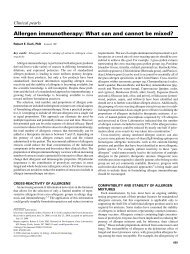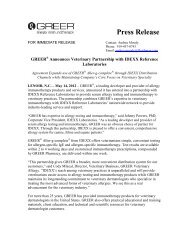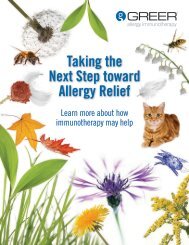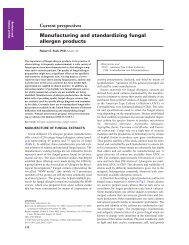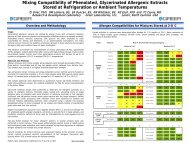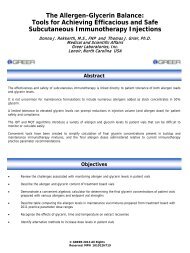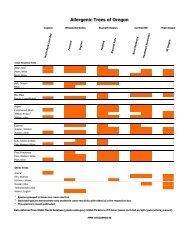Human Allergy Catalog - Greer
Human Allergy Catalog - Greer
Human Allergy Catalog - Greer
Create successful ePaper yourself
Turn your PDF publications into a flip-book with our unique Google optimized e-Paper software.
dilution, testing with individual extracts is more precise. False negative responsesmay occur if serum levels of antihistamines remain from prior medicationadministration. (See PRECAUTIONS) The use of a histamine positive control isespecially recommended for patients on prior medications which may decreasethe histamine skin test response.Skin tests read after 15 to 20 minutes are graded in terms of the induration(wheal) and erythema (flare) response compared to the appropriate controls.Wheal and flare sizes may be recorded by actual measurements. The largestdiameter of the wheal and flare may be recorded, or the sum of the largest diameterand the orthogonal (right angle) diameter wheal or flare may be used as inthe studies in TABLE 1 and TABLE 2.Scratch or Prick-puncture Skin Testing:For puncture, prick, or scratch skin test, the 10,000 BAU/mL strength isrecommended and will detect the more sensitive patients. Inconclusive results at10,000 BAU/mL may be followed by a puncture, prick, or scratch skin test at100,000. At the higher concentration, some nonspecific positives may occur.Controls for Scratch, Prick-Puncture Testing:As a positive control, glycerinated histamine phosphate 5 mg/mL (1.8 mg/mLhistamine base) or aqueous histamine phosphate 2.75 mg/mL (1 mg/mL (1:1,000w/v) histamine base) may be used as a positive control. A 50% glycerosalinesolution may be used as the negative control.Intradermal Skin Testing:Extracts for intradermal testing must be prepared by diluting the concentratedextract with sterile diluent (such as normal or buffered saline, or normal salinewith human serum albumin).Intradermal skin tests with eight U.S. reference extracts (TABLE 2) indicate thata calculated dose of 0.02 BAU/mL should yield an average sum of erythemareaction of 50 mm, as tested in subjects with similar puncture reactivitiesdescribed in TABLE 1 to that specific grass pollen extract. However in the moresensitive subjects, the dose was as low as 0.0003 BAU for one grass to 0.002 BAUfor several others. Conversely, doses of from 0.1 to 1.9 BAU were calculated toyield the same reaction in the least-sensitive subjects.Controls for Intradermal Testing:As a positive control, use glycerinated histamine phosphate diluted to 0.5 mg/mL(0.18 mg/mL histamine base) or aqueous histamine phosphate 0.275 mg/mL(0.1 mg/mL histamine base). As a negative control, use 0.5% to 1% glycerin in0.9% saline.A. Patients with a negative scratch or prick-puncture test:Patients who do not react to a scratch or prick-puncture test should betested intradermally, using a 26 or 27 gauge 1/4 inch needle, with 0.02 to0.05 mL of a 50 BAU/mL extract dilution. A negative test should befollowed by repeat tests using progressively stronger concentrations untilsignificant wheal and flare reaction sizes are attained or until the maximum11



